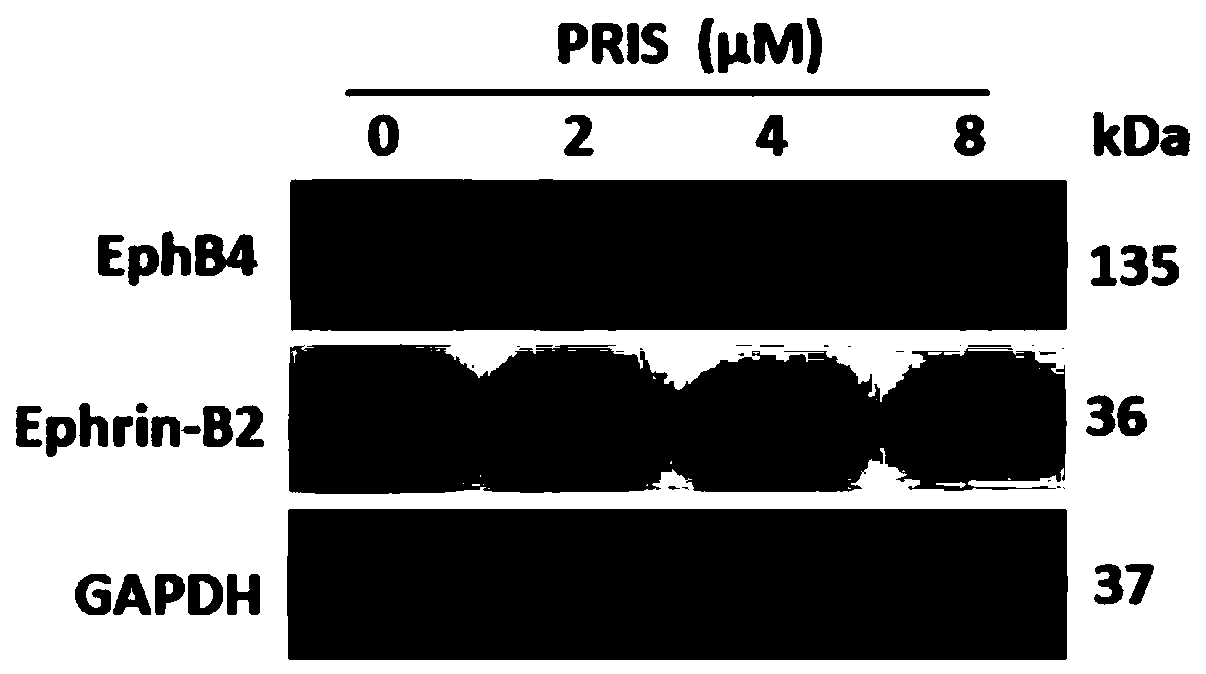New drug use of pristimerin
A technology of platyphyllin and its use, applied in the field of medicine, can solve the problems such as the application report of PRISEphB4/Ephrin-B2 signaling pathway inhibitor, etc., and achieve the effect of inhibiting tumor proliferation
- Summary
- Abstract
- Description
- Claims
- Application Information
AI Technical Summary
Problems solved by technology
Method used
Image
Examples
Embodiment 1
[0038] Example 1, PRIS inhibits the EphB4 / Ephrin-B2 signaling pathway
[0039] (1) CRLC cells were treated with various concentrations of PRIS (0, 2, 4, 8 μM) for 24 hours, and detected by Western blot, the results were as follows figure 1 As shown, PRIS inhibited the expression of EphB4 / Ephrin-B2 signaling pathway molecules EphB4 and Ephrin-B2 in a dose-dependent manner; the results of immunofluorescence staining were as follows: figure 2 As shown, EphB4 is expressed in the nucleus, and PRIS inhibits the expression level of EphB4 in the nucleus.
[0040] (2) NVP-BHG712 is a specific kinase inhibitor of EphB4, which can inhibit the autophosphorylation of EphB4, thereby inhibiting the forward transmission of EphB4 / Ephrin-B2 signal. CRLC cells were treated with PRIS and / or NVP-BHG712, and the results of Western blot detection were as follows image 3 As shown, NVP-BHG712 (0.1μM) significantly inhibited the expression of EphB4 and Ephrin-B2, and the EphB4 / Ephrin-B2 signaling p...
Embodiment 2
[0043] Example 2, PRIS acts as an inhibitor of EphB4 / Ephrin-B2 signaling pathway to inhibit cell proliferation, cell migration, and formation of vascular structures
[0044] (1) Analyze CRLC cells and normal human bronchial epithelial cells BEAS-2B, the results of mRNA analysis and western blot are as follows Image 6 As shown, compared with normal human bronchial epithelial cells, EphB4 is highly expressed in CRLC, which indicates that there is abnormal activation of EphB4 / Ephrin-B2 signaling pathway in non-small cell lung cancer.
[0045] (2) Use PRIS and / or NVP-BHG712 to treat CRLC cells, and the cell proliferation test results are as follows Figure 7 As shown, both PRIS and NVP-BHG712 (0.1 μM) inhibited the proliferation of CRLC cells through EphB4 / Ephrin-B2 signaling pathway inhibition.
[0046] (3) CRLC cells were transfected with PRIS and / or EphB4 siRNA, and the detection results of cell proliferation, cell migration, and in vitro lumen formation ability were as follo...
Embodiment 3
[0048] Example 3. PRIS promotes cell apoptosis by inhibiting EphB4 / Ephrin-B2 signaling pathway.
[0049] (1) Use PRIS as the EphB4 / Ephrin-B2 signaling pathway inhibitor to treat CRLC cells, and the results of cell apoptosis are as follows Figure 9 As shown, PRIS significantly promoted the apoptosis of CRLC cells ( Figure 9 A), measured by caspase activity, PRIS significantly increased the activity of caspase-9, caspase-3 and caspase-4 in a dose-dependent manner ( Figure 9 B), measured by caspase expression level, PRIS significantly increased the expression levels of activated caspase-9, activated caspase-3 and activated caspase-4 and cytochrome c ( Figure 9 C), caspase inhibitors include Z-LEHD-FMK for caspase-9 inhibition, Z-DEVD-FMK for caspase 3 inhibition, and Ac-LEVD-CHO for caspase 4 inhibition, such as Figure 9 As shown in D, these inhibitors all reversed the apoptosis promoted by PRIS, and it can be seen that PRIS promotes apoptosis by activating caspase.
[00...
PUM
 Login to View More
Login to View More Abstract
Description
Claims
Application Information
 Login to View More
Login to View More - R&D
- Intellectual Property
- Life Sciences
- Materials
- Tech Scout
- Unparalleled Data Quality
- Higher Quality Content
- 60% Fewer Hallucinations
Browse by: Latest US Patents, China's latest patents, Technical Efficacy Thesaurus, Application Domain, Technology Topic, Popular Technical Reports.
© 2025 PatSnap. All rights reserved.Legal|Privacy policy|Modern Slavery Act Transparency Statement|Sitemap|About US| Contact US: help@patsnap.com



